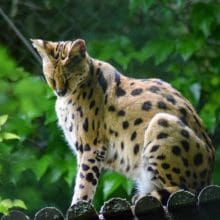What is a Liger? Understanding the Differences Between a Liger and a Tiger
What is a Liger?
When it comes to big cats, the tiger is often considered one of the most majestic and powerful creatures on Earth. However, have you ever heard of a liger? A liger is a hybrid cross between a male lion and a female tiger. In this article, we will explore the fascinating world of ligers and understand the key differences between them and their tiger counterparts.
The Origins of Ligers
Ligers are not found in the wild as they do not occur naturally. They are a result of captive breeding programs and are bred in controlled environments such as zoos and sanctuaries. The first recorded liger was born in India in the early 19th century. Since then, ligers have gained popularity due to their unique appearance and size.
What is a Liger: Size and Appearance
One of the most striking differences between ligers and tigers is their size. Ligers are the largest known cat species in the world. They can grow to be much larger than both lions and tigers. While tigers typically weigh between 200 to 600 pounds, ligers can weigh up to 900 pounds or more. Their immense size is a result of inheriting growth-promoting genes from both lion and tiger parents.
In terms of appearance, ligers have physical characteristics that resemble both lions and tigers. They have a lion-like body structure with a tiger-like coat pattern. Ligers often have a sandy or tawny coat with faint stripes. However, their stripes are usually less prominent than those of tigers.
Behavior and Temperament
When it comes to behavior and temperament, ligers exhibit a combination of traits from both lions and tigers. Like lions, ligers are social animals and tend to be more sociable than tigers. They enjoy the company of humans and other animals. However, ligers also inherit some solitary traits from tigers and may display territorial behavior.
tigers and may display territorial behavior.
Another interesting aspect of ligers’ behavior is their love for water. Unlike most big cats, ligers are known to enjoy swimming and playing in water. This behavior is more commonly seen in tigers, and ligers seem to have inherited this affinity from their tiger parent.
Health and Lifespan
While ligers are fascinating creatures, it is important to note that they often face health challenges due to their hybrid nature. Ligers can suffer from various health issues, including growth abnormalities, hormonal imbalances, and reduced fertility. These health concerns are a result of the genetic differences between lions and tigers.
Additionally, ligers have a shorter lifespan compared to their lion and tiger counterparts. On average, ligers live for around 10 to 15 years, whereas lions and tigers can live up to 20 years or more in the wild.
Conservation and Ethical Concerns
What is a Liger? While ligers may be fascinating to observe, there are ethical concerns surrounding their breeding and existence. Ligers are a result of human intervention and captive breeding, which raises questions about the conservation value of these hybrid animals. Some argue that resources and efforts should be focused on conserving and protecting purebred lion and tiger populations in the wild.
Furthermore, the breeding of ligers can sometimes be driven by profit and novelty rather than conservation efforts. It is crucial to ensure that the breeding of ligers is done responsibly and with the best interests of the animals in mind.
Summary
What is a Liger? ligers are a unique hybrid cross between a male lion and a female tiger. They are the largest known cat species in the world and exhibit a combination of physical and behavioral traits from both lions and tigers. While ligers may be fascinating to observe, it is important to consider the ethical concerns surrounding their breeding and existence. Understanding the differences between ligers and tigers can help us appreciate the diversity of the animal kingdom and make informed decisions about their conservation.
Read More About Ligers From Wikipedia




